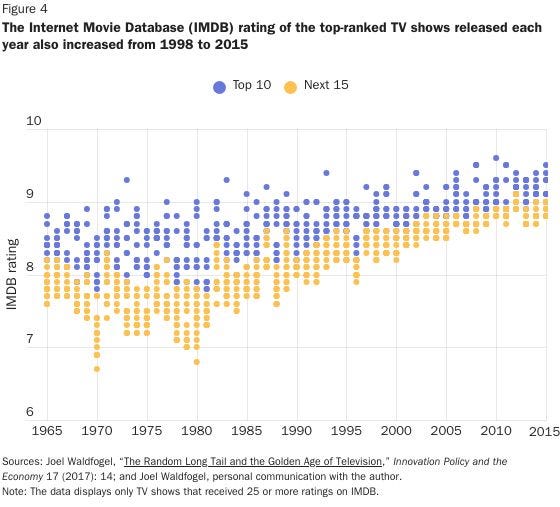The (Still) Golden Age of Film and Television
The decline of an industry is not the same thing as the decline of a medium
If you follow any film/tv writers, actors, or crew on social media, you’ve likely heard about how rough the industry has been since the WGA and SAG-AFRTA strikes of 2023. Some have blamed artificial intelligence for the slump, which makes no sense since AI substituting for labor is still a future hypothetical. The actual proximate cause is capital retrenchment after the unsustainable spending sprees that marked the streaming platform wars of the late-2010s and early 2020s.
Regardless, it is true that the traditional Hollywood studio system is facing major headwinds and it is unlikely to course correct any time soon. That’s because the ultimate cause of its decline is the rise of user-created visual content. Entertainment has always been an attention economy, but the rise of YouTube, TikTok, and social media platforms created new competition for scarce consumer eyeballs.
For a time, the Old Hollywood and New Media systems were able to coexist because smartphones dramatically expanded the total amount of time that people were both able and willing to look at screens. Watching stuff was no longer constrained to a weekly visit to the drive-in movie theater, or eating frozen dinners in front of primetime tv, or so on. The smartphone removed every technical and physical constraint on how much televisual content a person could watch. That meant a rising tide of consumption, enough for both new media to thrive and old media to survive.
But that moment of easy co-existence peaked with the pandemic lock-ins and a final boost in demand for content. Now, however, we’ve reached full saturation. There’s simply no remaining, underutilized time in the day when a screen isn’t available. And that means that the competition between old and new media has turned zero sum. If, for example, I’m watching a YouTube show, it’s now more likely to be something I watch instead of rather than in addition to a broadcast tv show.
The problem for the lumbering Hollywood studio system is that the revealed consumer preference is for nimble, innovative user-created content. People are watching less traditional tv and film but more TikToks, Shorts, YouTubes, etc. It’s understandable why this trend would be alarming to those employed by Hollywood studios, but the decline of Hollywood is not synonymous with the decline of filmed media writ large.
And remember, that decline is relative. Even with the recent contraction in the industry, traditional film and tv remain near historic highs for both production quantity and quality. Here’s the data for tv shows:
Those images come from a new essay I’ve written for the Cato Institute’s Globalization Project, in which I also discuss the remarkable rise of user-created video.
Streaming and cable have tripled the number of movies and quadrupled the number of TV shows released each year, [but] it is small peanuts compared to the volume of televisual content that users are creating and uploading daily. Five hundred hours of video is being uploaded to YouTube per minute! If the average person were to try and drink from that firehose—even dedicating every waking minute to the task—they would only make it through 832 minutes, or about half a day’s worth of upload in one entire lifetime. And that does not include other platforms that host video content, from TikTok to Twitch.
Click through to read the full essay; it starts with Bluey and ends with Mr. Beast. The core proposition is that it has never been easier for more people in more parts of the world to create, distribute, and watch high quality video. If you look at the big picture, rather than narrowly fixating on the decline of the Hollywood studio production model, then the future of video is actually quite bright.






You're stupid. Just saw your thing about not owning the drill. That consumerist mindset will be a demise of your own doing